
Apidae is the largest family within the superfamily Apoidea, containing at least 5700 species of bees. The family includes some of the most commonly seen bees, including bumblebees and honey bees, but also includes stingless bees, carpenter bees, orchid bees, cuckoo bees, and a number of other less widely known groups. Many are valuable pollinators in natural habitats and for agricultural crops.

The tribe Euglossini, in the subfamily Apinae, commonly known as orchid bees or euglossine bees, are the only group of corbiculate bees whose non-parasitic members do not all possess eusocial behavior.
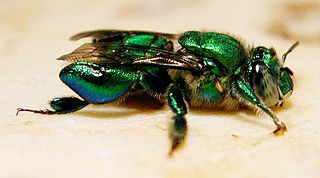
Euglossa is a genus of orchid bees (Euglossini). Like all their close relatives, they are native to the Neotropics; an introduced population exists in Florida. They are typically bright metallic blue, green, coppery, or golden.

Aglae is a genus of euglossine bees, with the only described species Aglae caerulea. Like all orchid bees, it is restricted to the Neotropics. They are metallic blue. This species, like the genus Exaerete, is a nest parasite on free-living Euglossini. A. caerulea lays its eggs in the nests of Eulaema nigrita, and possibly other Eulaema species.
Pappognatha is a genus of mutillid wasps. Some members of this genus are ant mimics. These wasps occur in Central and South America, and are parasites in the arboreal nests of orchid bees in the genus Euglossa.
The bee assassin, Apiomerus pilipes, is an insect that feeds on bees. It is found in South America and reported from Venezuela, Colombia, French Guyana, and Brazil. Like other members of the genus, females of this species have well-developed hind abdominal foliaceous appendages which can be coated with plant-derived resin.
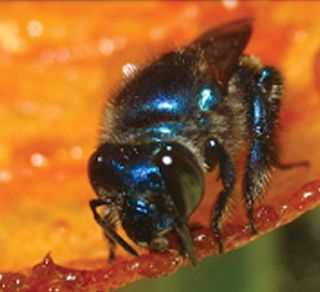
Euglossa hyacinthina, is a species of the orchid bee tribe Euglossini in the family Apidae. With a tongue that can get up to as long as 4 cm, this orchid bee species is found in Central America. Living in a neotropical climate, E.hyacinthina has adapted to hot and humid weather. The bee has darkly shaded, translucent wings and a metallic, glossy blue skeleton.

Euglossa bazinga is a euglossine bee species found in Brazil. It is named after the catchphrase of the fictional character Dr. Sheldon Cooper from the television show The Big Bang Theory. It was previously misidentified as Euglossa ignita, and is threatened with habitat loss.
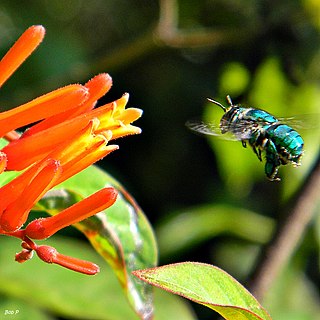
Euglossa dilemma, the green orchid bee or dilemma orchid bee, is a species of solitary euglossine bee native to a broad area of Central America, and recently introduced to Florida in the United States. It was first detected in Broward County, Florida in 2003, and initially identified as Euglossa viridissima, but further study revealed that E. viridissima as previously defined consisted of two cryptic species, and the one present in Florida was new to science.

Euglossa cordata is a primitively eusocial orchid bee of the American tropics. The species is known for its green body color and ability to fly distances of over 50 km. Males mostly disperse and leave their home nests, while females have been observed to possess philopatric behavior. Because of this, sightings are rare and little is known about the species. However, it has been observed that adults who pollinate certain species of orchids will become intoxicated during the pollination.
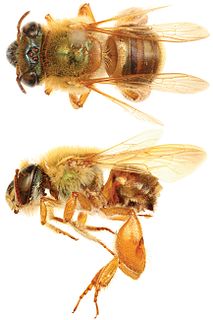
Euglossa decorata is a species of euglossine bee.
Euglossa jacquelynae is a Euglossine bee species found in Central Brazil.
Euglossa solangeae is a Euglossine bee species found in coastal southeastern Brazil. It is believed to be part of the Euglossa stellfeldi group.
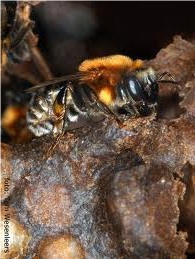
Melipona subnitida is a neotropical bee species in the Apidae family found in the dry areas of Northeastern Brazil. This species of stingless bees practices single mating, monogynous habits.

Euglossa imperialis is a bee species in the family Apidae. It is considered to be one of the most important pollinators to many Neotropical orchid species in mainland tropical America. It is also one of the most common non-parasitic euglossine species in lowland Panama. E. imperialis, unlike many other bee species, is not a social bee in the sense that there is no apparent morphological or physiological division within the species to distinguish individual bees to be part of a worker or reproductive caste.

Euglossopteryx is an extinct genus of bee in the family Apidae known from a fossil found in North America. There is one described species in the genus, Euglossopteryx biesmeijeri.

Euglossa mixta is a species of orchid bee native to Central America and South America, it is a member of the genus Euglossa a group of brilliant green and blue bees specialized in pollinating certain species of orchids.
Melipona quinquefasciata, commonly known as the mandaçaia-da-terra or mandaçaia-do-chão in Brazil, is a species of eusocial stingless bee in the family Apidae and tribe Meliponini.
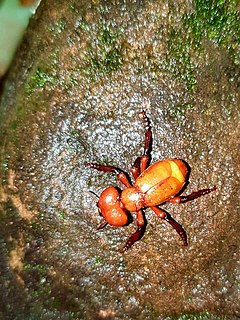
Meloetyphlus fuscatus, the blind blister beetle, is a species of blister beetle in the family Meloidae found in Central and South America. They are kleptoparasites of orchid bees and are entirely blind as adults. Unique among meloids, females do not lay their eggs near flowers, but rather within their hosts' nests.













